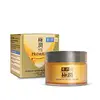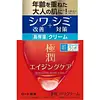What's inside
What's inside
 Key Ingredients
Key Ingredients

 Benefits
Benefits

 Concerns
Concerns

 Ingredients Side-by-side
Ingredients Side-by-side

Water
Skin ConditioningGlycerin
HumectantHydrogenated Polyisobutene
EmollientButylene Glycol
HumectantDipropylene Glycol
HumectantDimethicone
EmollientBehenyl Alcohol
EmollientTribehenin PEG-20 Esters
EmollientButyrospermum Parkii Butter
Skin ConditioningHydrogenated Castor Oil Dimer Dilinoleate
Skin ConditioningPentylene Glycol
Skin ConditioningPanthenol
Skin ConditioningNiacinamide
SmoothingLimnanthes Alba Seed Oil
Skin ConditioningHydroxyacetophenone
AntioxidantBetaine
HumectantOenothera Biennis Oil
EmollientHydroxyethyl Acrylate/Sodium Acryloyldimethyl Taurate Copolymer
Emulsion StabilisingCaprylic/Capric Triglyceride
MaskingTitanium Dioxide
Cosmetic ColorantSqualane
EmollientTocopherol
AntioxidantXanthan Gum
EmulsifyingSodium Stearoyl Glutamate
CleansingDipotassium Glycyrrhizate
HumectantHydrogenated Phosphatidylcholine
EmulsifyingDisodium EDTA
Ubiquinone
AntioxidantPolyhydroxystearic Acid
EmulsifyingAluminum Stearate
Cosmetic ColorantBisabolol
MaskingPolysorbate 60
EmulsifyingAlumina
AbrasiveHippophae Rhamnoides Oil
EmollientEuterpe Oleracea Fruit Oil
Skin ConditioningRubus Idaeus Seed Oil
EmollientOxycoccus Palustris Seed Oil
AntioxidantCalophyllum Inophyllum Seed Oil
AntimicrobialSodium Hyaluronate
HumectantHydrolyzed Sodium Hyaluronate
Skin ConditioningCarnosine
Skin ConditioningSorbitan Isostearate
EmulsifyingLavandula Angustifolia Oil
MaskingCamellia Sinensis Leaf Extract
AntimicrobialSodium Acetylated Hyaluronate
HumectantSodium Benzoate
MaskingLactic Acid
BufferingHydrolyzed Algin
Potassium Sorbate
PreservativeZingiber Officinale Root Extract
MaskingPhenoxyethanol
PreservativeHelianthus Annuus Seed Oil
EmollientSodium Hyaluronate Crosspolymer
HumectantRosmarinus Officinalis Leaf Extract
AntimicrobialCollagen
MoisturisingPalmitoyl Tripeptide-5
Skin ConditioningPalmitoyl Hexapeptide-12
Skin ConditioningWater, Glycerin, Hydrogenated Polyisobutene, Butylene Glycol, Dipropylene Glycol, Dimethicone, Behenyl Alcohol, Tribehenin PEG-20 Esters, Butyrospermum Parkii Butter, Hydrogenated Castor Oil Dimer Dilinoleate, Pentylene Glycol, Panthenol, Niacinamide, Limnanthes Alba Seed Oil, Hydroxyacetophenone, Betaine, Oenothera Biennis Oil, Hydroxyethyl Acrylate/Sodium Acryloyldimethyl Taurate Copolymer, Caprylic/Capric Triglyceride, Titanium Dioxide, Squalane, Tocopherol, Xanthan Gum, Sodium Stearoyl Glutamate, Dipotassium Glycyrrhizate, Hydrogenated Phosphatidylcholine, Disodium EDTA, Ubiquinone, Polyhydroxystearic Acid, Aluminum Stearate, Bisabolol, Polysorbate 60, Alumina, Hippophae Rhamnoides Oil, Euterpe Oleracea Fruit Oil, Rubus Idaeus Seed Oil, Oxycoccus Palustris Seed Oil, Calophyllum Inophyllum Seed Oil, Sodium Hyaluronate, Hydrolyzed Sodium Hyaluronate, Carnosine, Sorbitan Isostearate, Lavandula Angustifolia Oil, Camellia Sinensis Leaf Extract, Sodium Acetylated Hyaluronate, Sodium Benzoate, Lactic Acid, Hydrolyzed Algin, Potassium Sorbate, Zingiber Officinale Root Extract, Phenoxyethanol, Helianthus Annuus Seed Oil, Sodium Hyaluronate Crosspolymer, Rosmarinus Officinalis Leaf Extract, Collagen, Palmitoyl Tripeptide-5, Palmitoyl Hexapeptide-12
Niacinamide
SmoothingSodium Hyaluronate
HumectantHydrolyzed Hyaluronic Acid
HumectantSodium Acetylated Hyaluronate
HumectantAcetyl Glucosamine
Skin ConditioningWine Extract
AntioxidantButyrospermum Parkii Butter
Skin ConditioningTocopherol
AntioxidantGlycerin
HumectantButylene Glycol
HumectantCapric Acid
CleansingC20 Olefin
1,5-Pentanediol
SolventPolyglyceryl-5 Triisostearate
CleansingPEG-20 Sorbitan Isostearate
EmulsifyingPolyethylene
AbrasiveDimethicone
EmollientPullulan
Polyvinylalcohol Crosspolymer
Melaleuca Alternifolia Leaf Oil
AntioxidantSalicylic Acid
MaskingCitric Acid
BufferingBehenyl Alcohol
EmollientStearyl Alcohol
EmollientHyaluronic Acid
HumectantNiacinamide, Sodium Hyaluronate, Hydrolyzed Hyaluronic Acid, Sodium Acetylated Hyaluronate, Acetyl Glucosamine, Wine Extract, Butyrospermum Parkii Butter, Tocopherol, Glycerin, Butylene Glycol, Capric Acid, C20 Olefin, 1,5-Pentanediol, Polyglyceryl-5 Triisostearate, PEG-20 Sorbitan Isostearate, Polyethylene, Dimethicone, Pullulan, Polyvinylalcohol Crosspolymer, Melaleuca Alternifolia Leaf Oil, Salicylic Acid, Citric Acid, Behenyl Alcohol, Stearyl Alcohol, Hyaluronic Acid
Ingredients Explained
These ingredients are found in both products.
Ingredients higher up in an ingredient list are typically present in a larger amount.
Behenyl Alcohol is a type of fatty alcohol (these are different from the drying, solvent alcohols).
Fatty Alcohols have hydrating properties and are most often used as an emollient or to thicken a product. They are usually derived from natural fats and oils; behenyl alcohol is derived from the fats of vegetable oils.
Emollients help keep your skin soft and hydrated by creating a film that traps moisture in.
In 2000, Behenyl Alcohol was approved by the US as medicine to reduce the duration of cold sores.
Learn more about Behenyl AlcoholButylene Glycol (or BG) is used within cosmetic products for a few different reasons:
Overall, Butylene Glycol is a safe and well-rounded ingredient that works well with other ingredients.
Though this ingredient works well with most skin types, some people with sensitive skin may experience a reaction such as allergic rashes, closed comedones, or itchiness.
Learn more about Butylene GlycolThis ingredient is also known as shea butter. It is an effective skin hydrator and emollient.
Emollients help soothe and soften your skin. It does this by creating a protective film on your skin. This barrier helps trap moisture and keeps your skin hydrated. Emollients may be effective at treating dry or itchy skin.
Shea butter is rich in antioxidants. Antioxidants help fight free-radicals, or molecules that may harm the body. It is also full of fatty acids including stearic acid and linoleic acid. These acids help replenish the skin and keep skin moisturized.
While Shea Butter has an SPF rating of about 3-4, it is not a sunscreen replacement.
Shea butter may not be fungal acne safe. We recommend speaking with a professional if you have any concerns.
Learn more about Butyrospermum Parkii ButterDimethicone is a type of synthetic silicone created from natural materials such as quartz.
What it does:
Dimethicone comes in different viscosities:
Depending on the viscosity, dimethicone has different properties.
Ingredients lists don't always show which type is used, so we recommend reaching out to the brand if you have questions about the viscosity.
This ingredient is unlikely to cause irritation because it does not get absorbed into skin. However, people with silicone allergies should be careful about using this ingredient.
Note: Dimethicone may contribute to pilling. This is because it is not oil or water soluble, so pilling may occur when layered with products. When mixed with heavy oils in a formula, the outcome is also quite greasy.
Learn more about DimethiconeGlycerin is already naturally found in your skin. It helps moisturize and protect your skin.
A study from 2016 found glycerin to be more effective as a humectant than AHAs and hyaluronic acid.
As a humectant, it helps the skin stay hydrated by pulling moisture to your skin. The low molecular weight of glycerin allows it to pull moisture into the deeper layers of your skin.
Hydrated skin improves your skin barrier; Your skin barrier helps protect against irritants and bacteria.
Glycerin has also been found to have antimicrobial and antiviral properties. Due to these properties, glycerin is often used in wound and burn treatments.
In cosmetics, glycerin is usually derived from plants such as soybean or palm. However, it can also be sourced from animals, such as tallow or animal fat.
This ingredient is organic, colorless, odorless, and non-toxic.
Glycerin is the name for this ingredient in American English. British English uses Glycerol/Glycerine.
Learn more about GlycerinNiacinamide is a multitasking form of vitamin B3 that strengthens the skin barrier, reduces pores and dark spots, regulates oil, and improves signs of aging.
And the best part? It's gentle and well-tolerated by most skin types, including sensitive and reactive skin.
You might have heard of "niacin flush", or the reddening of skin that causes itchiness. Niacinamide has not been found to cause this.
In very rare cases, some individuals may not be able to tolerate niacinamide at all or experience an allergic reaction to it.
If you are experiencing flaking, irritation, and dryness with this ingredient, be sure to double check all your products as this ingredient can be found in all categories of skincare.
When incorporating niacinamide into your routine, look out for concentration amounts. Typically, 5% niacinamide provides benefits such as fading dark spots. However, if you have sensitive skin, it is better to begin with a smaller concentration.
When you apply niacinamide to your skin, your body converts it into nicotinamide adenine dinucleotide (NAD). NAD is an essential coenzyme that is already found in your cells as "fuel" and powers countless biological processes.
In your skin, NAD helps repair cell damage, produce new healthy cells, support collagen production, strengthen the skin barrier, and fight environmental stressors (like UV and pollution).
Our natural NAD levels start to decline with age, leading to slower skin repair, visible aging, and a weaker skin barrier. By providing your skin niacinamide, you're recharging your skin's NAD levels. This leads to stronger, healthier, and younger looking skin.
Another name for vitamin B3 is nicotinamide. This vitamin is water-soluble and our bodies don't store it. We obtain Vitamin B3 from either food or skincare. Meat, fish, wheat, yeast, and leafy greens contain vitamin B3.
The type of niacinamide used in skincare is synthetically created.
Learn more about NiacinamideSodium Acetylated Hyaluronate is a type of Hyaluronic Acid.
Hyaluronic Acids help moisturize, soothe, and protect the skin.
Read about common types of Hyaluronic Acid here:
Sodium Hyaluronate
Hydrolyzed Hyaluronic Acid
Hyaluronic Acid
Sodium Hyaluronate is hyaluronic acid's salt form. It is commonly derived from the sodium salt of hyaluronic acid.
Like hyaluronic acid, it is great at holding water and acts as a humectant. This makes it a great skin hydrating ingredient.
Sodium Hyaluronate is naturally occurring in our bodies and is mostly found in eye fluid and joints.
These are some other common types of Hyaluronic Acid:
Learn more about Sodium HyaluronateTocopherol (also known as Vitamin E) is a common antioxidant used to help protect the skin from free-radicals and strengthen the skin barrier. It's also fat soluble - this means our skin is great at absorbing it.
Vitamin E also helps keep your natural skin lipids healthy. Your lipid skin barrier naturally consists of lipids, ceramides, and fatty acids. Vitamin E offers extra protection for your skin’s lipid barrier, keeping your skin healthy and nourished.
Another benefit is a bit of UV protection. Vitamin E helps reduce the damage caused by UVB rays. (It should not replace your sunscreen). Combining it with Vitamin C can decrease sunburned cells and hyperpigmentation after UV exposure.
You might have noticed Vitamin E + C often paired together. This is because it is great at stabilizing Vitamin C. Using the two together helps increase the effectiveness of both ingredients.
There are often claims that Vitamin E can reduce/prevent scarring, but these claims haven't been confirmed by scientific research.
Learn more about Tocopherol